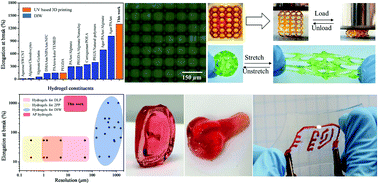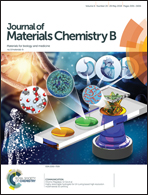Highly stretchable hydrogels for UV curing based high-resolution multimaterial 3D printing†
Abstract
We report a method to prepare highly stretchable and UV curable hydrogels for high resolution DLP based 3D printing. Hydrogel solutions were prepared by mixing self-developed high-efficiency water-soluble TPO nanoparticles as the photoinitiator with an acrylamide-PEGDA (AP) based hydrogel precursor. The TPO nanoparticles make AP hydrogels UV curable, and thus compatible with the DLP based 3D printing technology for the fabrication of complex hydrogel 3D structures with high-resolution and high-fidelity (up to 7 μm). The AP hydrogel system ensures high stretchability, and the printed hydrogel sample can be stretched by more than 1300%, which is the most stretchable 3D printed hydrogel. The printed stretchable hydrogels show an excellent biocompatibility, which allows us to directly 3D print biostructures and tissues. The great optical clarity of the AP hydrogels offers the possibility of 3D printing contact lenses. More importantly, the AP hydrogels are capable of forming strong interfacial bonding with commercial 3D printing elastomers, which allows us to directly 3D print hydrogel–elastomer hybrid structures such as a flexible electronic board with a conductive hydrogel circuit printed on an elastomer matrix.



 Please wait while we load your content...
Please wait while we load your content...